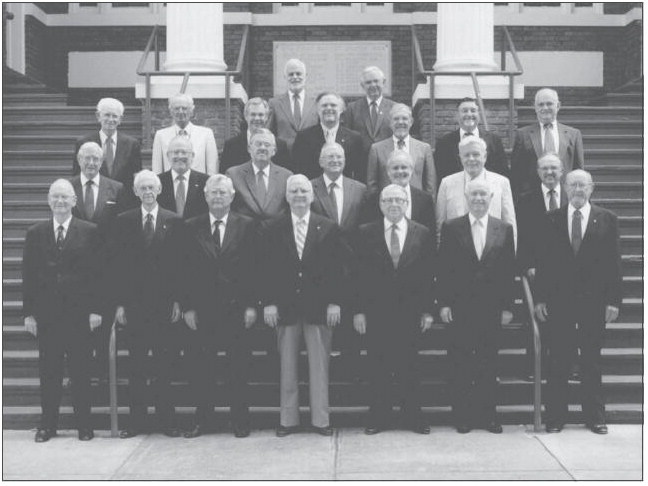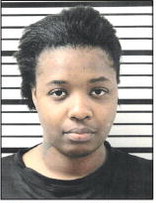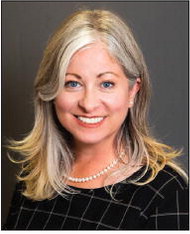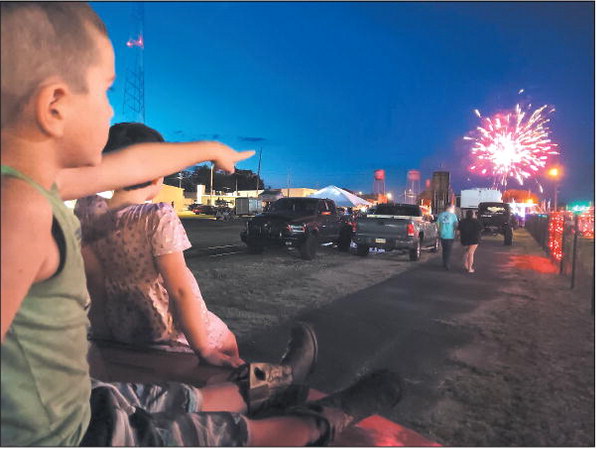74th Annual Citizens of the Year Banquet Slated for March 29
For almost three quarters of a century Vidalia has been honoring outstanding citizens for their contributions to the community.
It all began on December 14, 1949, when a beloved local doctor was honored, and through the years the recipients have included more local physicians, as well as lawyers, government and civic leaders, business moguls, philanthropists and devoted community volunteers.
But the Citizen of the Year is not just about a person’s profession or even the sum of their accomplishments. The rules that define the person who receives this honor are about much more. As one past recipient put it, “This is not a popularity contest.”
In fact, the committees that consider nominees take a close look at the character of the person, as well as the scope and extent of their community involvement — above continued from page
and beyond their profession or avocation. How did they touch lives over time and initiate lasting change in their community?
On March 29, the community will come together once again to honor Citizens of the Years at a banquet. Based on a tradition established in 2013 when local programs honoring both men and women merged, one man and one woman will be called on stage to receive accolades bestowed by the previous years’ recipients.
This year the ceremony is being celebrated as the 74th such occasion, but in actuality the event has separate origins and startup dates for men and women honorees. First Citizen of the Year
The first man honored was Dr. Joseph Eugene “Dr. Joe” Mercer, who was named 1948’s “Man of the Year” by the Vidalia Kiwanis Club. He was a native of Monticello but lived in Vidalia for 48 years where he maintained a busy general practice. Census records show that in 1940 he lived at 302 Durden Street with his wife, Frances Gay Mercer, and his daughter, Margaret, 17, (later Mrs. J.D. Ricketson). He also had a son, W.A. Mercer, who later lived in Cartersville. He was a veteran of World War I and a member of the American Legion, the Masonic Lodge and the American, Southern, Georgia and Southeastern Medical Associations. He was also a physician for Seaboard Airline Railroad and the Georgia and Florida Railroad and was elected President of the Toombs County Medical Society. He was a charter member of the Vidalia Kiwanis Club and remained active with the organization for 25 years. He also served as chairman of the Board of Education for several years.
He died in 1967 and his funeral was held at Vidalia’s First Methodist Church where he was a member of the church’s Board of Stewards. He was buried at Pinecrest Cemetery and four of his pallbearers had a first name of Mercer. As legend goes, they were named for the doctor because he brought them into the world. Dr. Mercer’s obituary, published January 12, 1967, in The Advance, stated: “The esteem with which he was held here, the dedication he had in the practice of his profession, the concern for the welfare of the citizenry, his family and community loyalty, was an inspiration that apparently prompted the establishment here of the annual plan of recognizing outstanding citizens, and in 1949, he was the first one so honored under the plan, having been named the Citizen of the Year for 1948.”
First Lady of the Year
The first woman who was honored as Vidalia’s “Lady of the Year” was Eloise Darby Shiplett. She received the honor in 1972 at an afternoon tea at First National Bank on May 8, 1972. The event was sponsored by the local Beta Gamma Chapter of Beta Sigma Phi Sorority. The main speaker was Paul Anderson, who was known internationally for his weight lifting skills as well as his home for youth established in Vidalia. Mrs. T.Q. Vann, a director of the sponsoring organization, Beta Sigma Phi Sorority, presented the first Lady of the Year award to Mrs. Shiplett. In making the presentation, Mrs. Vann said, “I am especially happy that Beta Sigma Phi conceived this idea of initiating this project. This is their way of expressing their appreciation, not only to today’s Lady of the Year, but to those who will follow her in the future appreciation for the fact that she has demonstrated concern and tolerance for her fellow beings and has helped to promote the cultural and finer things of life for each of us.” The daughter of James Frank Darby and Minnie Eloise Rimes Darby, Mrs. Shiplett was born in 1912 in Vidalia and was married to George Oder Shiplett, a prominent local lumber broker. They had a son, Franklin David Shiplett.
Mrs. Shiplett was known for her work with the Girl Scouts and served as a troop leader for over 15 years. She was a member of the Board of Directors of the Savannah Girl Scout Council and also served on the committee to formulate the redistricting of the Council, affecting 26 counties in Georgia and two counties in South Carolina.
In her obituary, printed in The Advance following her death on September 9, 1997, she was credited with reviving the Girl Scouting program in Vidalia. “Perhaps her greatest impact came from her efforts to rejuvenate Girl Scouting and provide citizenship and character building experiences for young girls including numerous occasions when she led groups of Girl Scouts on trips to Europe, Mexico, New York, Washington, and Atlanta.”
A charter member of Grace Methodist Church, Mrs. Shiplett was an active lay leader, serving in district posts for the South Georgia Methodist Conference. She was the first woman to serve on the Vidalia Recreation Board, being appointed when the Board was organized, and she was the first recipient of the Golden Deeds Award bestowed by the Vidalia Kiwanis Club. Evolution of the Event Since the tradition of naming Vidalia’s Citizens of the Year (originally, Citizen of the Year and Lady of the Year) began, the process of selecting and honoring these outstanding citizens has changed with the times. For the Citizen (Man) of the Year, the stream of honorees has flowed continuously from 1948. For the women’s event, whose history is briefer, a lot of change occurred since that program’s inception. This change involved a pause between ceremonies for the years 2009 to 2012, followed by reorganization, a merging of ceremonies for men and women, and a new title, “Citizens of the Year.”
In 1949, when Dr. Mercer was honored, social norms were much different. Men held prominent positions in the community and attended their own civic and social clubs, including the Kiwanis, Lions and Rotary clubs. In those days, although there were a few exceptions, most women did not work outside the home or hold local government positions, like serving on the City Council. Women were involved primarily in raising a family, in education and church work, and supporting their husbands.
In Vidalia, there were a few organizations that were the purview of women: the Woman’s Club, garden clubs, home economics groups, church organizations, school organizations like PTA, and charitable work. Through these organizations, many of them with national and international reach, women excelled and accomplished a lot of good for the community, the state, and the world. When Vidalia women began to honor their own with a “Lady of the Year” event, it was not through the organizations to which their husbands belonged. The women celebrated their “Woman of the Year” at teas or luncheons in their homes, at their churches, restaurants or at their own clubhouses. By the latter part of the 20th century social patterns had changed. Men and women were working more in a side-by-side capacity in the professional, governmental, and social arenas. A series of events led to the rethinking of how local citizens — both men and women — were honored.
In its early years, Vidalia’s Lady of the Year was sponsored by the Beta Gamma Chapter of the Beta Sigma Phi Sorority and this continued until 2009 when the organization disbanded. In 2012, Marsha Temples, Sheri Threlkeld, Karon Durden and other past recipients joined forces to save the event. “We decided that the tradition would die unless we stepped up to save it. We formed a group, separate from any civic group, got former recipients together and took on the project. All of the ladies who came to the initial meeting to reorganize the event were very much in favor,” Threlkeld said. By the next year, a Lady of the Year was honored.
Charles Andrew, a retired Vidalia attorney and historian for the Citizen (Man) of the Year project, recalled that by the time the women reorganized, the Lions and Rotary Clubs had merged with the Kiwanis to honor a Citizen of the Year. In 2013, the program’s bylaws were rewritten to accommodate the changes in the process, including honoring women. At that point, the event would be called Citizens of the Year Banquet. The criteria which govern the selection of both men and women for Citizen of the Year are similar. While input from the community at large is considered in the nomination process, no civic club selects honorees; rather, special, separate committees for both men and women honorees, along with past recipients, choose the next recipient. In the case of selecting the Lady of the year, the special nomination and selection committee reviews all nominees, narrows the field to three candidates; then, after additional research on these candidates, a final selection is made. The selection is kept secret until the new recipient is called on stage to accept the honor. Reflecting on how the event has changed over the years, Andrew noted that by the early 1980s, men’s clubs had started opening up to ladies. “Roles of women started to expand precipitously,” he said. Threlkeld and Temples, both past Lady of the Year recipients, recalled how, when the event first began, Vidalians Erin Jenkins and Frances Ledford were sponsors for Beta Sigma Phi. “Mrs. Jenkins was known for growing beautiful, yellow roses, so the symbol for the Sorority was a yellow rose,” Temples noted. “In the early 1970s, other than women’s clubs and church groups, there were not many outside groups for women. The progression of the ceremony mirrors how women’s roles expanded into leadership and professional positions,” Temples added.
Criteria
Each “Citizen of the Year” should be a person of notable character, with high ideals and principles, who has contributed his or her God-given talent, time, and possessions to improving Vidalia.
The recipient shall be determined on the basis of services and benefits rendered to other people or other objectives over and beyond excellence in one’s profession, business, or service enterprise, and extended over a period of not less than five years.
He or she should be one who has a fairly consistent “track record” for accomplishments rather than being known for a single act of merit, and who has been motivated by unselfish desire to serve their fellow citizens.
Past Recipients Who Were Related Though the years, Citizens of the Year have included married couples and members of the same family, who were honored at different events. Among these are James Darby, 1962, and his wife, Helen Darby, 1983; R.E. Ledford, 1970, and his wife, Frances Ledford, 1988; Harry Moses, Jr., 2016, and his wife, Jackie Moses, 2013; Dent Temples, 1995, and his wife, Marsha Temples, 2001; Dennis Ingley, 2008, and his wife, Therisa Ingley, 2018; Donald Estroff, 1985, and his wife, Anita Estroff, 2002; Reid Threlkeld, 2011, and his wife, Sheri Threlkeld, 1992; Thomas Fleming, 1980, and his wife, Lois Fleming, 2015; Tom P. Hutcheson, 1991, and his wife, Joan Hutcheson, 1994; John Ladson, 2017, and his wife, Sue Ladson, 2000; Wendell Dixon, 2001, and his wife, Elaine Dixon, 1998; and C.E. Pierson, 1958, and his wife, Lucy Pierson, 1977. Also, Jack Mosley, 1956, and his daughter, Jackie Moses, 2013; H.B. Estroff, 1955, and his son, Donald Estroff, 1985; Dr. Hubert Darby, 1991, and his son, Dr. Lloyd Darby III, 2015; Harry Moses Sr., 1997, and his son, Harry Moses, Jr., 2016; Anice McArthur, 1989, and her son, Reid McArthur, 2012; and G.H. (Howard) Threlkeld, 1952, his son, Larry Threlkeld, 1994, and Howard’s brother, Reid Threlkeld, 2011. Citizens of the Year, Men
1948: Dr. J.E. Mercer 1949: G.H. Achenbach 1950: H.S. Vandiver 1951: G.H. Gibson 1952: G.H. Threlkeld 1953: J.A. Crockett 1954: W. I. Oliver 1955: H. B. Estroff 1956: Jack L. Mosley 1957: F. D. Garrard 1958: C. E. Pierson 1959: Dr. Lamar Brown 1960: Brooks Brantley 1961: Norman Beggs 1962: James F. Darby, Jr. 1963: Charles W. Smith 1964: Delmas Wheeler 1965: Tommie Vann 1966: Benjamin Smith 1967: J.R. Trippe 1968: W.S. Snell 1969: Bill Hodges 1970: R. E. Ledford 1971: Barron W. Godbee, Jr. 1972: Dr. Hubert Darby, Jr. 1973: A.B. Davis 1974: Bill Warthen 1975: James D. West 1976: W. Winston Ivey 1977: W. F. Brown 1978: Harry P. Moses, Sr.
1979: George M. Garrett 1980: Thomas H.
Fleming 1981: Charles H. Andrew 1982: J. Edward Tyson 1983: W. Norwood Rhodes 1984: Lenard H. Anderson 1985: Donald H. Estroff 1986: Robert W. George 1987: W. Roy Fletcher 1988: George B. Chapman 1989: Fisher Barfoot 1990: Ronnie L. Stewart 1991: Tom P. Hutcheson 1992: Tom A. Peterson
III
1993: Bill Mitchell 1994: G. Larry Threlkeld 1995: Dent Temples 1996: Mac Jordan 1997: Chip Matheson 1998: Dan Murray 1999: Stephen A. Brown 2000: J. Richard Martin 2001: Wendell Dixon 2002: Gary Campbell 2003: Raymond Turner 2004: Jack Fields 2005: Marion Forrest 2006: Matt Oxley 2007: Michael R. Calhoun 2008: Dennis Ingley 2009: Terry Whigham 2010: Ray T. Blount 2011: Reid Threlkeld 2012: Reid McArthur 2013: Hoard Holman 2014: Howard Hill 2015: Dr. Lloyd H. Darby III 2016: Harry P. Moses,
Jr. 2017: John Ladson 2018: Zack Fowler 2019: Travis DeLoach 2020: James Thompson Citizens of the Year, Women 1972: Eloise Shiplett
FIRST CITIZEN OF THE YEAR Dr. J.E. Mercer was named by the Vidalia Kiwanis Club as 1948’s Citizen of the Year. He was honored as the first recipient of this award in a 1949 ceremony.
FIRST LADY – This photo from the 1972 edition of The Advance shows Eloise Shiplett receiving the award as the first Vidalia Lady of the Year in1972. At left is Mrs. P.J. Nix, President of the Beta Gamma Chapter and Mrs. T. Q. Vann, a Director of Beta Sigma Phi Sorority.
FORMER CITIZENS OF THE YEAR – Front row, from right, G.H. Achenbach, H.S. Vandiver, G.H. Gibson, J.A. Crockett, H. B. Estroff, Dr. Lamar Brown, Brooks Brantley. Second row: Delmas Wheeler, Benjamin Smith, W. S. Snell, Bill Hodges, Barron W. Godbee, Jr., Bill Warthen, James D. West. Third row: Winston Ivey, Harry P. Moses, Sr., Thomas H. Fleming, Charles H. Andrew, Jr., J. Edward Tyson, W. Norwood Rhodes, W. Roy Fletcher. Fourth row: George B. Chapman, Fisher Barfoot.
Photo by William F. Ledford, Sr.
continued from page
1973: Sarah Thompson
1974: Polly Rushton
1975: Estelle Jackson
1976: Gaynelle Davis
1977: Lucy Pierson
1978: Tad Saffold
1979: Mary Baker Rice
1980: Mildred Barker
1981: Peggy Reimers
1982: Lanette Reid
1983: Helen Darby
1984: Ruth Bond
1985: Francis Smith
1986: Dottie Brantley
1987: Twila Outzs
1988: Frances Ledford
1989: Anice McArthur
1990: Marcia Stuber
1991: Pam Thompson
1992: Sheri Threlkeld
1993: Carol Rice
1994: Joan Hutcheson
1995: Jane Pickren
1996: Ann Todd
1997: Retha Stewart
1998: Elaine Dixon
1999: Karon Durden
2000: Sue Ladson
2001: Marsha Temples
2002: Anita Estroff
2003: Lisa Adams
2004: Debbie Kitrell
2005: Mell Whipple
2006: Martha Davis
2007: Becky Smelser
2008: Myrt Page
2009-2012: No honorees
2013: Jackie Moses
2014: B.J. Davis
2015: Lois Fleming
2016: Patricia Dixon
2017: Carol Hansley
2018: Therisa Ingley
2019: Cindy Williams
2020: Pat Dixon
TICKET INFORMATION: Tickets for the 74th Annual Citizens of the Year Banquet are now on sale through March 18. The event is open to the public and will feature dinner and music preceding the award ceremony. Tickets are $30 and are available at the Vidalia Onion Museum or by calling 912-293-2214.








